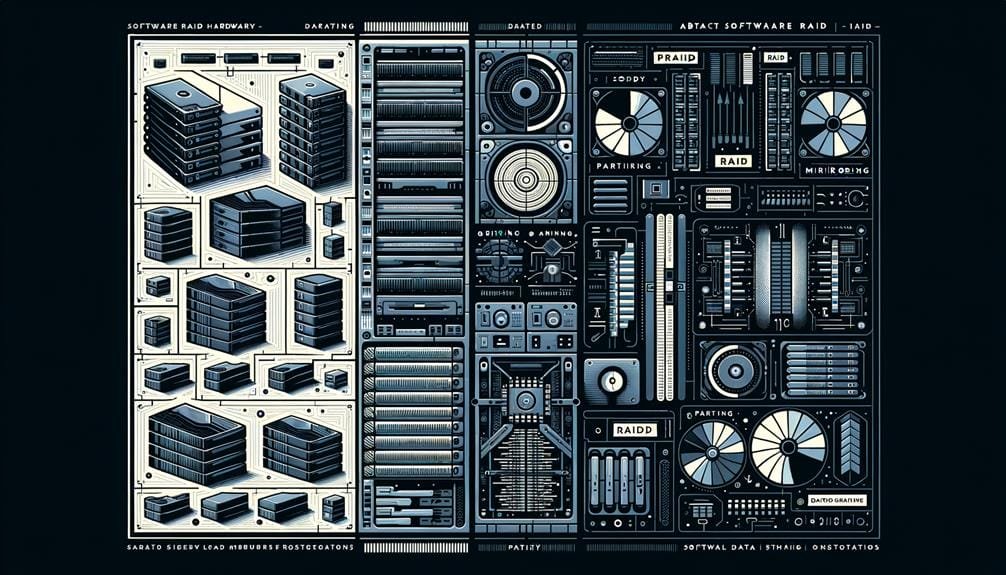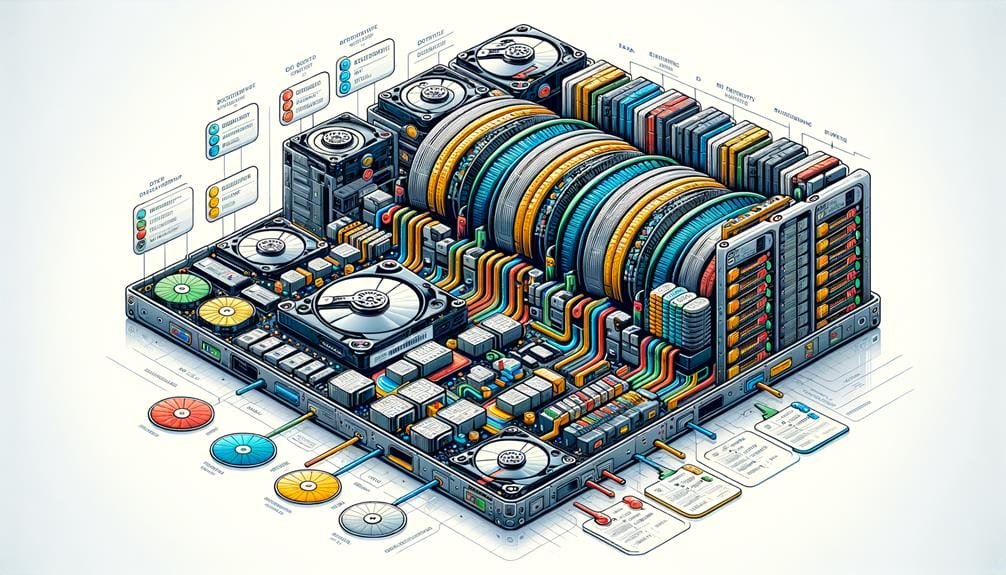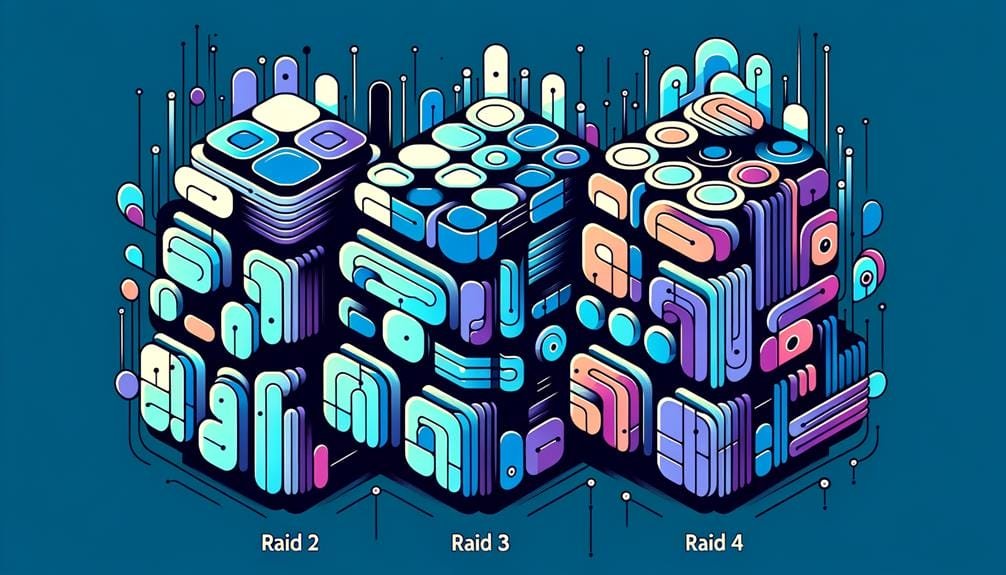Our Newsletter
Sign up for our e-mail newsletter and stay informed for what’s next on the horizon.
In the current technological era, the concept of data storage being confined to a single hard drive seems quite outdated. Progress has been substantial, and one of the advancements that have propelled us forward is the implementation of RAID configurations. These arrangements apportion data across several drives, achieving an equilibrium between performance and data safety.
However, what determines the suitability of one RAID level for certain tasks over another? How does a RAID 5 configuration contrast with a RAID 1, and under what circumstances might you prefer one to the other? Let’s investigate this crucial aspect of data storage.
In summary, understanding RAID configurations can be compared to deciphering a complex code – it’s crucial for optimal data storage and protection. These configurations have advanced substantially, offering a range of choices, each with their unique benefits.
Whether you prefer Hardware or Software RAID, or explore less popular categories, each choice affects your system’s performance. While common configurations dominate, unconventional variants also exist.
Therefore, it’s imperative to choose wisely, striking a balance between speed, redundancy, and cost.
To comprehend RAID storage, it’s pivotal to recognize that RAID, standing for Redundant Array of Independent Disks, is a method that combines several drives into a single entity to amplify performance and provide fault tolerance. This advanced technique refines data allocation and safeguarding, which is vital for time-critical and data-heavy processes. The significance of RAID storage in guaranteeing strong data protection and optimal system availability, even in the event of drive failures, can’t be overstressed.
Various RAID configurations, such as RAID 0, RAID 1, RAID 5, offer custom advantages to fulfill your unique requirements. Whether your priority is speed, redundancy, or a balance between security and performance, there’s a RAID configuration that fits your needs. These configurations play a vital role in boosting the efficiency of your storage system, representing arrays as a single logical unit, supervised by RAID controllers for increased performance and dependability.
When selecting a RAID configuration, flexibility is key. You should have the freedom to choose a system that aligns with your workflows, ensuring data safeguarding and redundancy without sacrificing performance. Comprehending RAID storage is the initial step to gaining this flexibility. And we’re here to assist you in taking that step.
We now focus on the development of RAID configurations. From its birth in 1987, RAID has transformed from an array of cost-effective disks into an array of autonomous disks. This shift has altered not just the interpretation of the acronym, but also resulted in the formation of various RAID levels.
Each RAID level presents unique data storage and safety configurations.
The term RAID was first introduced in 1987 by David Patterson, Randy Katz, and Garry A. Gibson, signifying a significant development in the progress of data storage configurations. It originally stood for Redundant Array of Inexpensive Disks; however, it was later modified to Redundant Array of Independent Disks.
In the foundational phase of RAID:
This transformational development has led to the flexible data storage options we have today.
As the years have passed, RAID configurations have seen substantial changes, moving from simple mirroring (RAID 1) and striping (RAID 0) methods to more intricate levels like RAID 5 and RAID 6. This development didn’t halt there. We witnessed the introduction of layered RAID levels, integrating the benefits of multiple levels for superior efficiency and fault tolerance.
Unconventional variants like RAID 7 and Adaptive RAID came into existence, offering features that surpass traditional levels, meeting specialized storage requirements. Throughout this development, RAID configurations continually provided a balance between efficiency, data protection, and storage effectiveness.
This chronicle of RAID configurations’ growth illustrates a continuous refinement of strategies to optimize data storage, dependability, and efficiency. We appreciate the ability to select the RAID configuration that caters to your unique needs.

Grasping the importance of RAID storage, we should acknowledge its crucial function in maintaining data security, providing fault tolerance, improving system reliability, and maximizing efficiency in data-heavy workflows. This positions RAID as a vital component of any data storage plan for organizations that prioritize data safety and accessibility.
RAID storage fundamentally tackles three crucial aspects:
Thus, when discussing data storage, RAID isn’t just a nice-to-have. It’s a requirement for any organization that values its data and requires constant, dependable access to it. We’ll examine specific RAID types in our subsequent subtopic to further comprehend their distinct benefits.
Focusing on the importance of RAID storage, we will now delve into the particulars of various RAID configurations, each tailor-made to fit distinct data storage requirements. Different RAID types provide different levels of data recovery, performance, and fault tolerance.
For instance, RAID 0 emphasizes speed without redundancy, utilizing a technique known as striping. Conversely, RAID 1 employs mirroring for data safety, offering a straightforward yet effective failover solution. RAID 5 and RAID 6, in contrast, strike a balance between performance and reliability by combining striping with single or double parity, respectively.
Let’s illustrate the differences with this table:
| RAID Type | Key Feature | Ideal Use Case |
|---|---|---|
| RAID 0 | High Performance | Non-critical data |
| RAID 1 | Data Duplication | Critical data storage |
| RAID 5/6 | Parity + Speed | Balance between speed & reliability |
Each configuration has a specific purpose and provides unique advantages. They offer the flexibility to select the perfect balance between speed, data recovery, and fault tolerance. Keep in mind, the choice of RAID type greatly influences your data storage strategy. Thus, make a wise decision based on your specific requirements.

Our focus now shifts to the comparison and contrast of Hardware and Software RAID.
Hardware RAID, with its dedicated controller, brings superior dependability and performance to the table, whereas the system resources utilized by software RAID provide it with adaptability.
We’ll juxtapose these two varieties, scrutinizing their individual merits and demerits in the subsequent dialogue.
When discussing Hardware RAID, we should recognize that it employs a unique, dedicated controller for improved efficiency and dependability, distinguishing it from its software equivalent. This type of RAID is notably effective with RAID 5 and RAID 6 setups, making it a preferred selection for many tech-inclined individuals.
To aid your comprehension, let’s dissect it:
In simple terms, hardware RAID configurations provide a versatility and adaptability that’s hard to match.
Switching our focus, we’ll examine Software RAID, a budget-friendly choice that, in contrast to its hardware equivalent, utilizes the host CPU for processing, which could potentially impact the overall system performance.
When we opt for software RAID, the disk performance may decrease as the host CPU balances between regular tasks and managing RAID functions. This is why software RAID configurations are ideal for smaller-scale systems and home users who desire basic data redundancy.
Not needing any specialized hardware, software RAID can be set up on most operating systems, providing you a choice. Nevertheless, in high-demand circumstances, software RAID mightn’t reach the dependability and high performance of hardware RAID. Thus, make a careful selection based on your individual requirements and resources.
After discussing the intricacies of Software RAID, we now shift our focus to a comparative examination of Hardware and Software RAID setups.
In the comparison of hardware RAID and software RAID, efficiency is a key consideration.

In grasping the operational mechanics of RAID, we first note how it partitions data across numerous drives to boost both performance and fault resistance. It wisely presents these arrays as a single logical unit, simplifying the task for the operating system. This is where RAID controllers step in, effectively handling these storage-focused arrays.
Moving on to specific details, RAID utilizes methods such as disk mirroring and striping, contingent on the RAID levels in use. Disk mirroring, implied by the name, generates an exact duplicate of the data on two drives. This redundancy fortifies data protection, ensuring your data isn’t lost if one drive malfunctions.
Striping, conversely, distributes data across multiple drives. This accelerates the data writing process, augmenting overall performance. By dispersing I/O operations over numerous drives, RAID significantly boosts fault resistance. This is a crucial reason why RAID is a preferred solution for high-availability systems.
Fundamentally, RAID’s operational mechanism is a shrewd blend of hardware and software tactics, constructed to optimize speed, dependability, and data security. With RAID, you’re not merely storing data; you’re protecting it.
Let’s now shift our focus to the frequently used RAID configurations. Grasping the various RAID levels and knowing how to employ them is vital for optimal data storage.
In this section, we’ll examine the features, advantages, and ideal scenarios for RAID 0, RAID 1, RAID 5, and RAID 6.
Let’s explore the different RAID levels, each offering a unique mix of speed and dependability to cater to specific data storage needs. Striping, mirroring, and parity are all fundamental aspects of various RAID levels, presenting a range of solutions for diverse needs.
We have:
With these RAID levels, you can construct a data storage system that matches your speed necessities, reliability demands, and the liberty to select. Your decision, your command.
After understanding the varied RAID levels, we’re set to implement these typical RAID configurations and comprehend their distinctive advantages and particular uses.
A RAID 0 array employs striping devoid of redundancy, offering a speed enhancement but falling short in data safeguarding.
Conversely, RAID 1 arrays utilize mirroring to duplicate data, providing a fail-safe storage solution.
For those desiring a mix of velocity and dependability, RAID 5 merges striping with parity, enabling data restoration in case of a drive failure.
Each setup serves distinct objectives, providing unique advantages based on the demands. Hence, grasping the use of each RAID configuration enables you to opt for the most suitable solution for your data storage necessities.

Exploring less common RAID configurations, we encounter options like RAID 2, RAID 3, RAID 4, and RAID 5E. Each of these has unique advantages and characteristics that are ideal for specific storage situations. Let’s examine each to understand their distinctive features.
RAID 2 stripes data at the bit-level and uses Hamming code for error correction. Although this offers excellent data protection, it’s rarely used for general-purpose storage due to its intricacy and expense.
RAID 3 employs byte-level striping with a dedicated parity disk. This grants robust data protection, but it may have difficulty managing multiple requests at the same time, limiting its flexibility.
RAID 4 uses block-level striping with a separate parity disk. It’s swift for read operations but slower for writes, making it a good fit for applications with a heavy read bias.
RAID 5E is a RAID 5 variant that includes reserved space for immediate array rebuilding after a drive failure, achieving a balance between performance and fault tolerance.
These lesser-known RAID configurations offer a variety of options for those who appreciate choice in their data storage solutions. They present alternatives to more frequently used RAID levels, broadening the potential for customized data storage setups.
When evaluating the performance of various RAID configurations, we note that RAID 0, 1, 5, and 6 each bring unique advantages in terms of speed, data protection, and fault tolerance. RAID 0, as an example, boosts performance by employing data striping across multiple disks. However, its lack of redundancy leaves it susceptible to data loss.
Contrarily, RAID 1 prioritizes data duplication over speed, ensuring dependability and backup storage capabilities. It’s a fitting choice for those who place data security above all else. Additionally, there’s RAID 5, a setup that strikes a balance between speed and data protection. It merges striping with parity, delivering both performance and security.
Lastly, RAID 6 introduces double parity striping, providing a superior level of fault tolerance and data protection. This arrangement suits those seeking the utmost level of redundancy and reliability.

Let’s shift our focus to non-standard RAID variants, which bring in additional features and modifications for improved performance, versatility, and data redundancy. Standard RAID levels offer solid data storage solutions, but they may not fit all situations. This is where non-standard RAID setups step in, providing extra options for data storage and access.
Included in these are:
Our aim is to equip you with information about these non-standard RAID setups, giving you the freedom in choosing the suitable data storage solution. Keep in mind, the optimal RAID setup for your needs depends on your particular performance, redundancy, and data storage requirements.
Wrapping up, grasping RAID configurations is akin to interpreting a complicated cipher – it’s vital for ideal data storage and safety. They’ve progressed significantly, providing a variety of options, each possessing distinct advantages.
Whether you opt for Hardware or Software RAID, or venture into less common categories, each decision influences your system’s efficiency. And while prevalent configurations rule, non-standard versions are also present.
Hence, it’s critical to select thoughtfully, achieving a balance between speed, redundancy, and expense.
The topic at hand is RAID configuration in storage, which unites several disks into a single entity. This enhances speed and fault tolerance, dispersing data through methods such as striping, mirroring, and parity, for improved data retrieval and safeguarding.
A common inquiry we receive revolves around the three primary RAID setups. These are RAID 0, RAID 1, and RAID 5. RAID 0 boosts performance, RAID 1 provides redundancy, and RAID 5 merges both to achieve an optimal balance.
The topic at hand is methods of RAID storage, encompassing striping, mirroring, and parity. Striping helps in enhancing performance, mirroring contributes to redundancy, and parity imparts fault tolerance. Different RAID configurations utilize these combinations to meet particular performance and redundancy objectives.
We’re examining the seven RAID levels: RAID 0, 1, 2, 3, 4, 5, and 6. Each possesses distinctive traits, advantages, and compromises, offering varying balances of speed, data safeguarding, and storage capacity.
Sign up for our e-mail newsletter and stay informed for what’s next on the horizon.